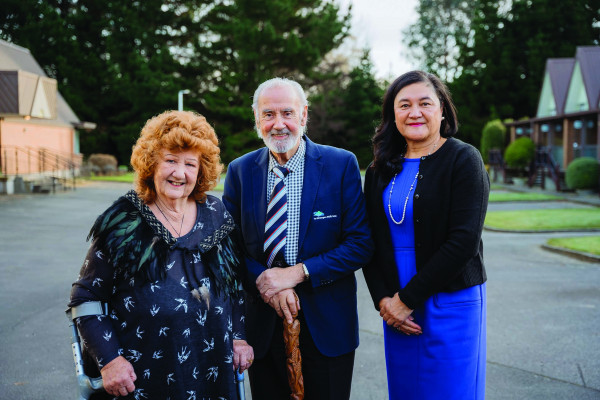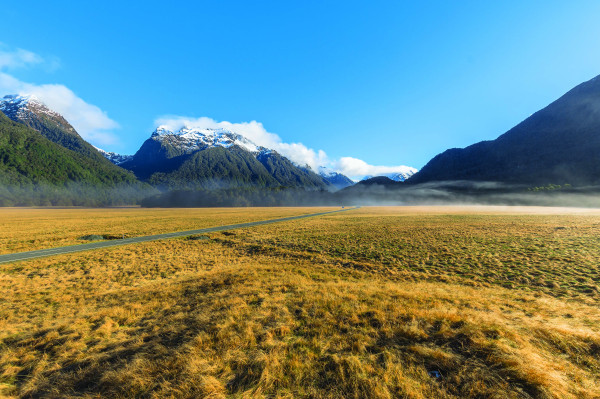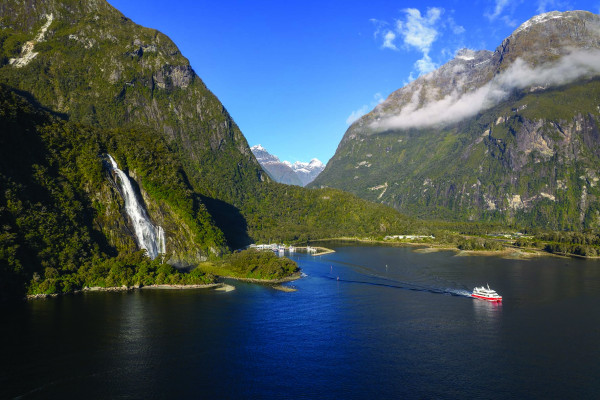Reimagining Piopiotahi
Aug 5, 2024

Nā Anna Brankin
For many years, Kāi Tahu has been limited from safeguarding and engaging with many of our sacred sites, including Piopiotahi and the Milford Corridor. This is beginning to change, with initiatives like the Milford Opportunities Project dreaming of a new future for the region – one that embraces Kāi Tahu culture and identity while addressing challenges posed by more visitors and an ageing infrastructure. The project team reached a milestone in June, presenting their masterplan to the government. Kaituhi Anna Brankin reports.
Buried deep in the southwest corner of Te Waipounamu is a region renowned for its spectacular and dramatic landscapes: rugged cliffs, cascading waterfalls, dense native bush and pristine waters. Known to the rest of the world as Fiordland, Kāi Tahu call it Te Rua-o-te-Moko – and the jewel in its crown is Piopiotahi, or Milford Sound.
According to Kāi Tahu creation stories, the rugged terrain of Te Rua-o-te-Moko was the work of demigod and master carver Tū Te Rakiwhānoa. He travelled to Te Waipounamu in search of his tipuna Aoraki, only to discover he had been turned to stone alongside his brothers to form the highest peaks of Kā Tiritiri o te Moana – the Southern Alps.
Using his adze Te Hamo, Tū Te Rakiwhānoa carved the land to form the deep fiords, peaks and plateaus of Te Rua-o-te-Moko, providing a safe haven for the arrival of his human descendants. He began at the southern edge and perfected his technique as he moved north, considering the last fiord, Piopiotahi, to be his greatest achievement.
Kāi Tahu has maintained a connection with Te Rua-o-te-Moko for centuries, through whakapapa and place-based practices such as mahika kai and pounamu extraction. There was an extensive transport network into the region that included coastal routes and well-worn inland trails dotted with established nohoanga sites for seasonal occupation.
The region is laden with ancient names carried from Hawaiiki to Aotearoa, demonstrating that no place was too remote for Kāi Tahu to explore and name. These names form part of our historic knowledge system; oral maps that assist current and future generations to understand Te Rua-o-te-Moko and find their place within it.
Today, eight Papatipu Rūnaka exercise mana whenua in the region: Ōraka Aparima Rūnaka; Te Rūnanga o Makaawhio; Te Awarua Rūnaka; Waihōpai Rūnaka; Hokonui Rūnanga; Te Rūnanga o Moeraki; Kāti Huirapa ki Puketeraki and Te Rūnaka o Ōtākou.
This rich history is one of many reasons Muriel Johnstone (Ngāi Tahu, Ōraka Aparima) jumped at the opportunity to sit on the board of the Milford Opportunities Project.“My personal interest in the kaupapa was heightened knowing how treasured this place was to our collective tīpuna, through the kōrero, wāhi ingoa and pūrākau shared by my own Pōua and Taua,” she says. “My involvement formally began in 2017, although of course mana whenua had been expressing concern and frustration for some time. We could clearly see increasing stressors and problems.”
The remote environment of Te Rua-o-te-Moko is a stronghold for native flora and fauna, and it’s recognised as a UNESCO World Heritage site, while its iconic beauty makes it a draw card for international tourism. Visitor numbers to Piopiotahi have more than doubled since 2012, with most tourists making the eight-hour round trip from Queenstown in a single day.
The current management of recreation and tourism along the Milford Corridor and at Piopiotahi poses a threat to the very things that make this place special: its untouched beauty and unique natural environment.

Milford Opportunities Project board members Muriel Johnstone, Michael Skerrett and Arihia Bennett. PHOTOGRAPH: Blackfeather Studios
Since 2017, the Milford Opportunities Project has been exploring ways to meet this challenge by implementing a self-funded, sustainable tourism system. It’s a collaboration between Kāi Tahu, the Department of Conservation, Southland District Council, the Ministry of Transport, Waka Kotahi, the Ministry of Business, Innovation and Employment and Environment Southland.
The project board includes Kāi Tahu directors Muriel Johnstone and Michael Skerrett as well as former Te Rūnanga o Ngāi Tahu chief executive Arihia Bennett. They sit alongside directors representing local and central government as well as the tourism industry, and are tasked with ensuring Kāi Tahu rights and interests are upheld.
Michael Skerrett (Ngāi Tahu, Waihōpai) says their involvement has been a welcome opportunity to regain a foothold in this significant area. “It is a real opportunity for us to get back in place. Back in the 1960s it was virtually only our Ngāi Tahu fishermen operating out of Piopiotahi before the tourism boats crept in and they were shifted,” he says.
“It’s a cultural desert in there, and this project gives us the opportunity to adorn the place with our carvings and artworks and interpretations, and in doing so restore our culture and enhance the visitor experience.”
In 2021, the project team put forward the Milford Opportunities Masterplan, and for the past two years has been testing its recommendations. The result of this work was recently presented to the government in the hope of a new approach. The team is in it for the long haul. “The masterplan recommends many changes to enhance conservation and tourism over a 50-year time frame,” says Muriel.
“This is a forward-looking project and much will develop as time, funding and future proposals are considered.” The proposed changes are woven through with Kāi Tahu ideas and aspirations for the region, with a focus on generating revenue that can be poured back into protecting the natural environment.
“Charging international visitors is one of the main recommendations. As New Zealanders, we pay for conservation through our taxes but tourists have been getting a free ride,” Michael says. “It’s only fair that they pay to protect the environment they’re enjoying visiting, and our researchers actually found that most visitors are willing to do so.”
Other recommendations within the masterplan include controlling access with an express park-and-ride service from Te Ana-au (Te Anau) using zero emission buses, minimising congestion along the Milford Corridor. The 120 kilometre drive from Te Ana-au to Piopiotahi is one of the most scenic stretches of road in the world, yet as it stands most visitors travel along it without stopping.

The road into the spectacular Milford Sounds. PHOTOGRAPH: supplied
Development of experiences along the corridor, as well as tourism infrastructure in Te Ana-au, will increase overnight stays and be a catalyst for growth. There are additional safety recommendations, including provisions for the Piopiotahi workforce to live elsewhere to offset the omnipresent earthquake and tsunami risk.
There are also provisions for Kāi Tahu stories to be incorporated into any new development, increasing the visibility of iwi in the region. This includes the installation of a pou whenua designed by master carvers Steve Solomon, James York and Fayne Robinson, to mark the entrance of Te Rua-o-te-Moko. The eight-metre pou whenua will tell the creation story of the area.
Within Piopiotahi itself, a waka landing will be established. “This tauraka waka will be reinstated as close to the original site as possible, allowing waka ama and cultural activities to once again have their right places in this treasured area,” says Muriel.
The masterplan also advocates for the restoration of traditional place names in the region, in keeping with a national trend to embrace Māori names and the rich stories behind them.
For example, there are many accounts of the meaning behind the name Piopiotahi. One story is that Piopiotahi was the name of a waka that travelled from Hawaiki to gather pounamu, while another states that the famed explorer Māui travelled to the region and named the fiord after his pet bird – piopio being a now-extinct songbird.
“We’ve been encouraged to be quite bold, so we asked the question, ‘Is it Milford Sound, or is it Piopiotahi?’” says Arihia Bennett. “And we ultimately decided it is and has always been Piopiotahi, so that’s what we’re putting forward.”
Arihia joined the board at the end of 2023, a valuable addition with her experience at Te Rūnanga o Ngāi Tahu and her knowledge of Piopiotahi. She has a longstanding connection to the region, spending seven years there in the 1990s, working first as a lodge manager and later as a branch manager for Fiordland Travel, now Real New Zealand.
“I’ve been really impressed with the board in terms of their openness and genuineness in hearing Ngāi Tahu views,” Arihia says. “It’s right up the front in bright lights, that any changes must align with the aspirations of the iwi and the expectations of our Deed of Settlement.”
Michael agrees, saying it has been a constructive experience from the outset – and very different from several boards and working groups he’s been part of over the years.
“It’s been an exciting and enjoyable experience, working with really good people. They buy into what we’re trying to achieve, and they understand the meaning of article two of the Treaty: that we have tino rangatiratanga, or absolute authority, over forest, fishes, settlements and other taonga.”
For the iwi it’s imperative that as a premier attraction experiencing more visitors, the approach to tourism at Piopiotahi must acknowledge Kāi Tahu tino rakatirataka and provide opportunities for the iwi to participate in the local tourism industry.
“If this plan is enacted, we will have the opportunity for our people to find employment in our own takiwā, or even to explore business ventures with Papatipu Rūnanga and Ngāi Tahu Holdings,” says Michael. “For 26 years we’ve been waiting for certain provisions from our Deed of Settlement to be enacted, and with this plan we might be able to achieve it.”
Under Section 4 of the Conservation Act 1987, the Crown must give practical effect to the principles of Te Tiriti o Waitangi. One way this can be done is by enabling iwi to reconnect to ancestral lands by taking opportunities through concessions that grant permission for a business or enterprise on conservation land.
Ngāi Tahu Holdings has expressed interest in taking over certain concessions within Piopiotahi and along the corridor, but the current system favours incumbents. The masterplan recommends changes to the concession system that would allow the iwi to participate in emerging opportunities.
“There is obviously an interest from the tribe in pursuing future opportunities that come about not only at Piopiotahi but along the Milford Corridor through to Te Ānau,” Arihia says. “Those opportunities could be anything from whānau businesses, through to Papatipu Rūnaka enterprises, through to investments by Ngāi Tahu Holdings.”

Hineteawa (Bowen Falls) with Piopiotahi village in the background. PHOTOGRAPH: supplied
As well as the potential financial gains, the iwi believes it has a key role to play in the tourism industry when it comes to exercising mana whenua and enhancing visitors’ experience.
“These are our ancestral lands, and out of that comes a responsibility as much as anything to embody our values of kaitiakitanga and manaakitanga,” Michael says. “Many historical sources tell us that Pākehā settlers said they wouldn’t have survived here if it hadn’t been
for the support of our ancestors. Today, that translates to providing a safe and enjoyable experience to visitors.”
Although the Kāi Tahu directors appreciate the support and positive feedback they’ve received from their colleagues on the Milford Opportunities Project, they say it’s important to note that Kāi Tahu is not asking for permission to exercise its tino rakatirataka – merely for the space to do so.
“It’s acknowledged in legislation that we hold tino rakatirataka within our tribal takiwā,” Michael says."Tino rakatirataka is not just about Kāi Tahu authority; it’s about kaitiakitaka and manaakitaka – stewardship and care for people and place. As Muriel says, “This is how we can be part of the solution in growing conservation alongside other opportunities, while still safeguarding our great taonga Piopiotahi, the Milford Corridor from Te Ana-au, and the wider area.”